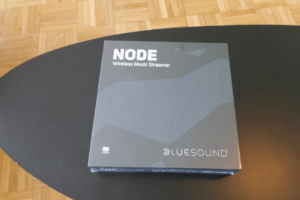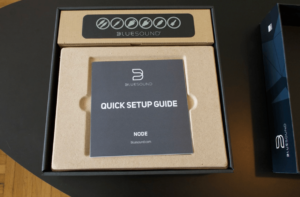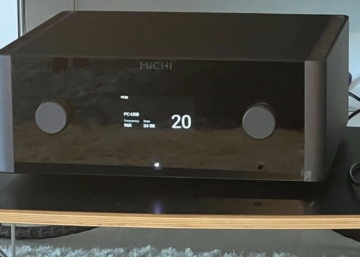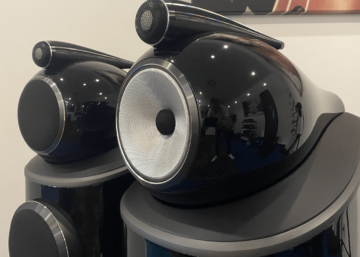Audio Score – Bowers & Wilkins 800 Diamond (D2) – Audio Speakers Review
Introduction

Bluesound Node N130 – audioscaleurs
The source is a key component for your listening experience, no matter if it is analog or digital. Over the years, I have used many streamers and DACs at various price levels, before I finally settled in with my Linn Majik DS1. This review is about the Bluesound N130, the latest revision of the Bluesound lineup, replacing the Node 2i.
The Node was up against my memory of the predecessor Node 2i, and its predecessor, the Node 2. In my listening room, it was in A/B comparison against the Linn and the internal DAC of the Mcintosh C47 stereo preamplifier. I played around extensively with using the DAC in the Bluesound, the Linn and the Mcintosh. The general setup consisted of the streamer connected to the C47, into the Mcintosh MC302 and the Bowers & Wilkins 800 Diamond (D2) speakers. All electronics were connected to the Isotek Aquarius 3 EVO, a device I will not let go off for a while.
The Bluesound
The Bluesound was packaged similar to its predecessors. It comes with various power cords/plugs for the regions, an analog cable, a manual and the device itself. At a price of 549 Euros, the packaging is adequate but nothing more. After taking out the Bluesound and connecting it to the preamp via a Goldkabel highline coax cable, the power cord and the RJ45 network cable, the BluOS app pretty much immediately finds the new device in the network. The initial setup via RJ45 Ethernet is very simple and straight forwards.

Bluesound Node N130 – Audiophile
To get some sound out of the device, I set up my Qobuz account in the IOS APP and started streaming. 15 minutes after unboxing the device, I was listening to the tunes of Dire Straits. Overall, the setup and installation are dead simple and can be done just with the Phone (Blusound APP) and the ethernet connection to the Router. If you don’t have ethernet, you can also pair the Node 130 via Bluetooth and Wifi, to stream music with and also via your smartphone.
If you ever have the chance to check out hifi-audio in Düsseldorf, please do. They are not only very competent, but also have a huge selection of high-end stuff. For the last 20 years, I have been a happy customer and can highly recommend a personal visit or digital on: hifi-audio.de
The Audio Scaleurs Sight & Sound Score, or The A3S-Score
The feature set of the new Node is vast. In addition to the already amazing Node 2i, the Node 130 also packs an HDMI ARC port, which allows you to connect it to your television. With that you can make use of the internal DAC of the N130 and connect it to your vintage hifi-system via analog-out. I think this is a great addition to the device because it increases the versatility. I found myself connecting my SONY TV via HDMI ARC to the Node and going out analog to the Mcintosh Preamp quite often.
The device is also equipped with all sorts of connectivity – Bluetooth, WIFI, Ethernet are standard. It also supports Airplay 2 to stream from your apple devices. If this streamer lacks features, you will hardly find an alternative that delivers more.
Usability has improved significantly over the predecessor. The user interface in the app is snappy, easy and very stable. It is one of the easiest and best performing UI’s on the market and with the latest processing power, it is even a step up from the already snappy Node 2i. I still remember going from the Node 2 to the 2i with a significant bump in speed and usability. The same accounts for the N130. You will enjoy using it with all sorts of streaming services or as a DAC.
I don’t want to split hairs, but I had very high sonic expectations with the new revision of the Node. Those were not fully met.
This doesn’t mean the Node does not perform, but I did not hear any difference to the predecessor. The predecessor was already so good, giving the Linn a run for its money, that there was little to complain about. Especially at this price point. The Node’s internal DAC delivers a very detailed, analytical sound, with a very textured bass, midrange and detailed upper end. The DAC resolves very accurately, has great rhythm and timing. It simply does an excellent job with sending a quality analog signal to its playing partner.
The Linn is no match in usability or speed, but it has a certain warmth to the DAC, without being washed out, that the N130 does not have. It has more character.
The DAC of the N130 sounds very similar to the DAC in the Mcintosh C47, with a little bit more focus on the upper end of the frequency range, or maybe the Mcintosh and Linn sound more refined and less sharp at the upper end?
The N130 is a great addition to audiophile setups in a wide price range. It digitizes analog systems, connects TVs to them and is extremely easy to use with all its connectivity and smart software.
The N130 not only does that, but it is also very audiophile, sonically capable and opens the door to high-end audio for a huge audience.
In the target market, I am sure the N130 will hardly be the weakest link in the setup.
If you want more, you must invest heavily into the streamer, the DAC, amplification, and speakers. Then you audit them, and you will end up spending big bucks.
Ps, you need an audioscore for your equipment? Contact me.
FOLLOW ME!
- Instagram – https://www.instagram.com/audioscaleurs/
- Facebook – https://www.facebook.com/Audioscaleurs
- YouTube – https://www.youtube.com/channel/UC1fyOvUcq0StoYp2BW5kp0Q



